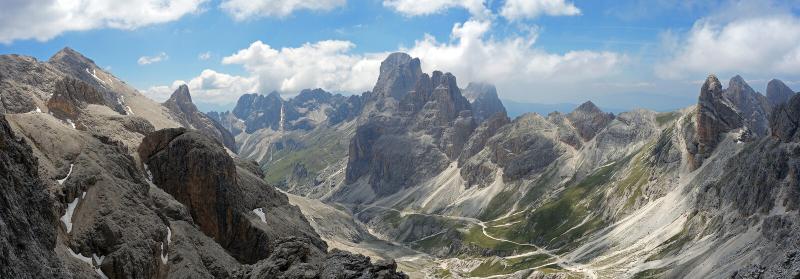Hiking in the Fabled Catinaccio Group of the Dolomites
ITA:

Use player to listen to Italian version
Once upon a time, a population of dwarfs ruled by the wise King Laurin dwelled among the rocky massifs of what is now known as the Catinaccio group of the Dolomites. King Laurino had a beautiful daughter, Ladina, who every day tended to an immense rose garden. One day, King Latemar, from the nearby mountain of the same name, approached the garden to find out how the roses could grow in such a wild and inhospitable place. When he saw Ladina, he immediately fell in love and kidnapped her. Devastated, King Laurin put a curse on the flowers because they had revealed where his kingdom was: they were never to grow again, not in the day, not at night. But in his desperation, he forgot to mention the sunrise and sunset, which is when the mountains of the Catinaccio turn a pinkish hue – the so-called enrosadira (which is in fact due to the calcium carbonate and magnesium carbonate of the dolomite, the mineral that makes up the Dolomites and gives the mountain range its name).
[Another version of the legend says that it was King Laurin to fall in love with a princess, Similda. He kidnapped her, but she was rescued by her people and Laurin was captured. His kingdom had been filled with roses which had helped the enemy find him, so he cast a spell on the flowers not to ever be seen again during day or night, but he forgot dusk, which is when the roses appear in their glowing splendor.]
Both King Laurino legends were invented to explain the enrosadira; and they also inspire the German name for Catinaccio: Rosengarten, garden of roses.
The Italian name – Catinaccio - derives from the Ladin Ciadenac (the Romance language spoken by the Ladin people who live in some of the valleys of the Dolomites) and it is said to refer to the coarse gravel that is typical of the Catinaccio.
Located between the Fassa, Ega e Tires valleys of South Tyrol, the Catinaccio group, which is one of the nine Dolomite massifs in Unesco’s World Heritage list, is served by numerous, well-marked paths and trails, which take to such famous natural wonders as the Vajolet Towers or the small Antermoia Lake. The group is crossed by many smaller valleys and passes and is dotted with mountain huts, where it is possible to try the local cuisine or sleep overnight on longer treks.
There are also many via ferrata and climbing routes. The highest peak is the Catinaccio d’Antermoia (3004m), which was first climbed in 1872.
C'era una volta una popolazione di nani governata dal saggio Re Laurino che dimorava tra i massicci rocciosi di quello che oggi è conosciuto come il gruppo del Catinaccio nelle Dolomiti. Re Laurino aveva una bellissima figlia, Ladina, che ogni giorno si occupava di un immenso roseto. Un giorno, il re Latemar, che viveva nelle montagne vicine, si avvicinò al giardino per scoprire come le rose potevano crescere in un luogo tanto selvaggio e inospitale. Quando vide Ladina, se ne innamorò subito e la rapì. Devastato, il re Laurino scagliò una maledizione contro i fiori perché avevano rivelato dove si trovava il suo regno: non sarebbero mai più ricresciuti, né durante il giorno, né durante la notte. Ma, nella sua disperazione, dimenticò di menzionare l'alba e il tramonto, quando le montagne del Catinaccio si tingono di una sfumatura rosata – il fenomeno dell’enrosadira (che in realtà è dovuto al carbonato di calcio e al carbonato di magnesio della dolomia, il minerale che compone le Dolomiti e dà il nome al gruppo montuoso).
[Un'altra versione della leggenda dice che fu Re Laurino ad innamorarsi di una principessa, Similda. La rapì, ma ella fu salvata dalla sua gente e Laurino catturato. Il suo regno era pieno di rose che avevano aiutato il nemico a trovarlo, così lanciò una maledizione ai fiori determinando che non potessero essere mai più visti né di giorno né di notte, ma dimenticò il crepuscolo, che è quando le rose appaiono nel loro lucente splendore.]
La leggenda del re Laurino fu inventata per spiegare l'enrosadira, ed è anche l’ispirazione per il nome tedesco del Catinaccio: Rosengarten, giardino di rose.
Il nome italiano - Catinaccio - deriva dal ladino (la lingua romanza parlata dal popolo ladino che vive in alcune vallate delle Dolomiti), Ciadenac, e si dice che faccia riferimento alla ghiaia dolomitica tipica della catena.
Situato tra la Val di Fassa, e le valli Ega e Tires dell'Alto Adige, il gruppo del Catinaccio, uno dei nove massicci dolomitici parte del Patrimonio Mondiale dell'Unesco, è attraversato da numerosi sentieri ben segnalati, che portano a famose meraviglie naturali come le Torri del Vajolet o il piccolo lago di Antermoia. Il gruppo è attraversato da molte piccole valli e passi ed è costellato di rifugi, dove è possibile fermarsi a provare la cucina locale o a dormire per i percorsi più lunghi.
Ci sono anche molte vie ferrate e vie di arrampicata. La vetta più alta è il Catinaccio d'Antermoia (3004 m), che fu scalato per la prima volta nel 1872.











